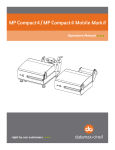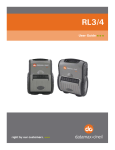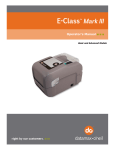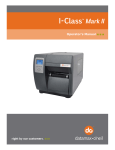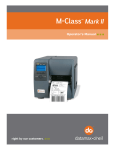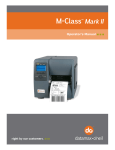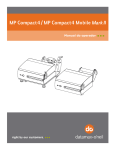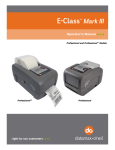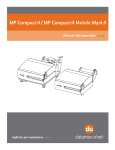Download Datamax O'Neil A-Class Mark II Compact4 Mobile Mark II
Transcript
Operators Manual Copyright Information CG Triumvirate is a trademark of Agfa Corporation. CG Times based upon Times New Roman under license from the Monotype Corporation. Windows is a registered trademark of the Microsoft Corporation. All other brand and product names are trademarks, service marks, registered trademarks, or registered service marks of their respective companies. Limitation of Liability In no event shall Datamax-O’Neil be liable to the purchaser for any indirect, special or consequential damages or lost profits arising out of or relating to Datamax-O’Neil’s products, or the performance or a breach thereof, even if Datamax-O’Neil has been advised of the possibility thereof. Datamax-O’Neil’s liability, if any, to the purchaser or to the customer of the purchaser hereunder shall in no event exceed the total amounts paid to Datamax-O’Neil hereunder by the purchaser for a defective product. In no event shall Datamax-O’Neil be liable to the purchaser for any damages resulting from or related to any failure or delay of Datamax-O’Neil in the delivery or installation of the computer hardware, supplies or software or in the performance of any services. Some states do not permit the exclusion of incidental or consequential damages, and in those states the foregoing limitations may not apply. The warranties here give you specific legal rights, and you may have other legal rights which vary from state to state. Firmware (Software) Agreement The enclosed Firmware (Software) resident in the Printer is owned by Licensor or its suppliers and is licensed for used only on a single printer in the user’s Trade or Business. The User agrees not to, and not to authorize or permit any other person or party to, duplicate or copy the Firmware or the information contained in the non-volatile or programmable memory. The firmware (Software) is protected by applicable copyright laws and Licensor retains all rights not expressly granted. In no event will Licensor or its suppliers be liable for any damages or loss, including direct, incidental, economic, special, or consequential damages, arising out of the use or inability to use the Firmware (Software). Information in this document is subject to change without notice and does not represent a commitment on the part of Datamax-O’Neil Corporation. No part of this manual may be reproduced or transmitted in any form or by any means, for any purpose other than the purchaser's personal use, without the expressed written permission of Datamax-O’Neil Corporation. All rights reserved Copyright © 2010, Datamax-O’Neil Part Number 88-2351-02, Revision B Important Safety Instructions This printer has been carefully designed to provide many years of safe, reliable performance. As with all types of electrical equipment, however, there are a few basic precautions you should take to avoid hurting yourself or damaging the equipment: • • • • • • • • • Carefully read the provided installation and operating instructions. Read and follow all warning instruction labels on the printer. Place the printer on a flat, firm, solid surface. Make sure all openings on the printer remain unblocked; never insert anything into the openings or ventilation slots. Do not place the printer near a heat source. Do not use your printer near water, or spill liquid into it. Be certain that your power source matches a listed voltage rating for the printer (if unsure, check with your dealer or local utility company). Do not place the power cord where it can be stepped on; and, if the power cord becomes damaged, immediately replace it. If service is required, use only qualified trained technicians to repair your printer. Agency Compliance and Approvals UL60950-1; 1st Edition CSA C22.2 No. 60950-1-03 1st Edition EN60950-1 (2001) 1st Edition IEC60950-1 (2001) 1st Edition The manufacturer declares under sole responsibility that this product conforms to the following standards or other normative documents: EMC: EN 55022 (1993) Class A EN 50024 (1998) Safety: This product complies with the requirements of EN 60950-1, 1st Edition WARNING!: This is a Class A product. In a domestic environment this product may cause radio interference in which case the user may be required to take adequate measures. Contents 1 Getting Started 1.1 Introduction................................................................................................. 1 1.2 Unpacking ................................................................................................... 1 2 Printer Setup 2.1 Power Connection......................................................................................... 3 2.2 Interface Connection..................................................................................... 4 2.3 Loading Labels ............................................................................................. 5 3 Printer Operation 3.1 Front Panel .................................................................................................. 7 3.1.1 Status Light Conditions......................................................................... 7 3.1.2 Control Button..................................................................................... 7 3.1.3 Configuration Label .............................................................................. 8 3.2 Windows Driver............................................................................................ 9 3.3 Printer Configuration Utility (TeraTerm) ..........................................................10 4 Maintenance and Adjustments 4.1 Cleaning Intervals .......................................................................................13 4.2 Cleaning the Printhead .................................................................................14 4.2.1 Cleaning Film Procedure....................................................................14 4.2.2 Cotton Swab Procedure.....................................................................15 4.3 Printhead Replacement.................................................................................16 4.4 Platen Roller Replacement ............................................................................18 4.5 Printhead Pressure Adjustment......................................................................20 4.6 Media Sensor Configuration ..........................................................................21 4.7 Downloading Firmware .................................................................................22 Appendix A - Specifications Appendix B - Ethernet Setup i ii 1 Getting Started 1 1..1 1 IIn nttrro od du uccttiio on n Congratulations on your MP Compact4 Mark II printer purchase. The MP Compact4 Mark II printer family, hereafter referred to as ‘the printer’, blends the rugged durability of die-cast construction with state-of-the-art electronics and user-friendly features to redefine the standard in industrial thermal printers. The printer’s USB, RS232 serial, or optional wired and wireless LAN connectivity allows easy interfacing to any host system. This manual provides all the information necessary to operate the printer. To print labels or tags, simply refer to the instructions included with the software you have chosen to create the labels. A Windows printer driver can be found on our website (http://www.datamaxoneil.com) or on the included CD-ROM for printing from common applications. If you wish to write a custom program, a copy of the Class Series 2 Programmer’s Manual can also be found on the CD-ROM. 1 1..2 2 U Un np pa acck kiin ng g After removing the printer from the packaging material, check the contents. The following items should be included: Printer Power Cord Serial Cable (p/n 502542) Cleaning Card (p/n 70-2087-01) CD-ROM and Documentation Any special or additionally purchased items Additional Requirements: The following items are necessary for generating labels from your printer. Contact your customer support or sales representative for advice on which media and software may best be suited for your application. USB Cable Ethernet cable for optional LAN connectivity Applicable Label Media It is a good idea to save all packaging materials in the event that shipping the printer is ever required. 1 2 2 Printer Setup 2 2..1 1 P Po ow we err C Co on nn ne eccttiio on n Power Connections Before connecting Power or interface cables to the printer, ensure the Power On/Off Switch is in the ‘Off’ position. Place the printer on a firm, level surface. Ensure that the Power Switch on the Printer is in the ‘Off’ position. AC Model Connect the AC Power Cord to the receptacle on the back of the Printer, and then plug the AC Power Cord into a properly grounded outlet. (The printer’s power supply automatically detects and then adjusts to the applied line voltage; see Appendix A for the acceptable voltage ranges.) DC Model (24VDC to 48VDC) Connect the Black wire to the negative (-) pole of the battery or chassis ground. Connect both red wires to the positive (+) pole of the battery. Connect the white input connecter to the rear of the printer as shown. (The printer’s power supply automatically detects and then adjusts to the applied voltage; see Appendix A for the acceptable voltage ranges.) 3 2 2..2 2 IIn ntte errffa acce eC Co on nn ne eccttiio on n The printer can be connected to the host via the USB, serial, wired Ethernet, or optional wireless. The printer will automatically connect to the first port that delivers valid data. Once established, the printer’s power must be cycled ‘Off’ and ‘On’ to change an interface connection. LAN (RJ45 wired Ethernet) USB Wireless antenna connector (optional) COM 1 (RJ45) Before connecting Power or interface cables to the printer, ensure the Power On/Off Switch is in the ‘Off’ position. Serial Connections (COM1) The serial interface supports RS-232C communications via a RJ45 connector. The following list of serial port settings is menu selectable (via host software/driver) and must match the host computer’s serial port settings: > Baud Rate (Default 9600 bps) > Word Length (Default 8 bits). Serial to Parallel Converter An optional serial to parallel converter cable (part# 540707) is available for applications that require a parallel connection to the host. USB Connection (USB) The USB Interface is supported in Windows 95 and greater. Depending upon the operating system of your host computer, installation may differ slightly. Wired and Optional Wireless For setup information on wired and optional wireless connections, see Appendix B. 4 2 2..3 3 LLo oa ad diin ng g LLa ab be ellss Load media into the printer as follows: 1. Rotate the Printhead Latch clockwise to the unlocked position. AC Models 2. Printhead Latch DC Models Remove the Media Hub Guide: AC Models: Move the Thumb-Latch to the released position and then slide the Media Hub Guide off the Media Hub. Media Hub Guide Thumb-Latch Media Hub DC Models: Loosen the Media Guide Handle and slide the Media Hub Guide off the Media Hub. 5 Media Hub Guide Media Guide Handle Media Hub 3. Unravel approximately 12” of labels from the Label Roll. Slide the labels and Label Roll into the printer from the side as shown. 4. Label Roll Reinstall the Media Hub Guide onto the Media Hub. Be sure the Media Hub Guide is lightly touching the edge of the Label Roll. Secure the Media Hub Guide: AC Models: Move the Thumb-Latch to the locked position DC Models: Tighten the Media Guide Handle, do not over-tighten. AC Models Media Hub Guide Printhead Latch Media Hub Label Roll Thumb-Latch Media Guide Handle DC Models 5. Rotate the Printhead Latch counter-clockwise to the locked position. AC Models DC Models 6. Turn the printer ON and wait for it to enter an idle state (green light on). Press the front Control Button a couple of times to position the media and ensure proper tracking. If the printer does not correctly sense the top of each label, it may be necessary to calibrate the printer (see Section 4.6 Media Sensor Configuration). 6 3 Printer Operation 3 3..1 1 F Frro on ntt P Pa an ne ell The printer is equipped with a single multi-function Control Button and tri-color Status Light. 3.1.1 Status Light Control Button Status Light Conditions (Green) (Yellow) (Red) (Red Flashing) 3.1.2 Ready to print. Printer is in Hex Dump Mode, see Section 3.1.3. Out of stock\labels or printer jam. Clear the printer jam or reload labels as necessary; press the Control Button to clear. Internal printer temperature is too hot, printer has entered a “cool down” mode. Control Button Status Light 'Green' (Ready Mode) With the status light solid green the control button will function as follows: Printer at Idle - Printer feeds media to the next label. Printing Labels - Pauses Printer, press again to resume. Status Light 'Red' (Paused or Error Condition) The red status light indicates that operator attention is required. In this state pressing the control button will function as follows: Printer is Paused - Printer resumes normal operation; Press and hold for 3 seconds to cancel current print job. Error Mode - Clears error, feeds media to next label and resumes operation. Printer Reset The printer can be reset by pressing and holding the Control Button for at least 10 seconds, then release the button, the Status Light will turn off momentarily. Resetting the printer will clear RAM of downloaded images, fonts, label formats, and remove temporary printer configuration changes. 7 3.1.3 Configuration Label Initiation of this mode causes the printer to print its Configuration Label and to begin the Hex Dump Mode. The Configuration Label provides valuable printer information including the firmware version, memory allocations, enabled options, communications settings, and label-counter data. To print the Configuration Label: 1. Be sure the printer is properly loaded with media (at least 4 inches wide), and that the power to the printer is off. 2. Turn on the printer. 3. When the Status Light turns on, press and hold the Control Button until printing begins. After the printer has completed printing the Configuration Label the printer will enter Hex Dump Mode. In this mode, all data sent to the printer will be immediately output in hexadecimal code, along with the printable ASCII equivalents. The Hex Dump Mode is a useful tool for advanced users in the diagnosis of problems including communications, handshaking, and label format syntax errors. To decode this information, the Programmer’s Manual is an essential reference. To exit Hex Dump Mode simply turn the printer off. 8 3 3..2 2 W Wiin nd do ow wss D Drriiv ve err The Windows driver is located on the Accessories CD-Rom included with your printer. For the latest version please visit our web site at www.datamax-oneil.com. Installing the Windows Driver: Place the Accessories CD-Rom included with your printer into your computers CD-Rom drive. Once the CD-Rom starts select your printer model and then select "Install Windows Driver" from the menu. When prompted, select your printer from the list, (e.g. MP Compact4 Mark II). Continue to follow the onscreen instructions to install the driver. Important Notes: The Windows driver functions the same as any other Windows printer. A built in help file is available for complete information on all settings; however, there are some important settings that should be observed for trouble free printing. Stocks Tab: Define Stock It is important that the Stock setting matches the size of the label you are using. Click 'New' and enter the dimensions of your label. The Windows application software used to create the label format will likely have a "Page Setup" screen. This will also need to match the size of the label you are using. 9 3 3..3 Te 3 P erra Prriin aT Te errm ntte m)) err C Co on nffiig gu urra attiio on nU Uttiilliitty y ((T TeraTerm (located on the Accessories CD-ROM) is a Windows based configuration utility that allows the user to make changes to the existing printer setup via a direct connection to the host serial port, or any port with a Windows driver assigned to it. The following list highlights what operations can be defined in the different menu sections: TeraTerm will not be able to connect to the printer if the Windows driver is installed on the same port. To temporality resolve this issue, re-assign the Windows driver port to “File”. This will free the port and allow TeraTerm to communicate with the printer. Ports: Configure the COM ports or give the printer an IP-address (network settings). Label Settings: Set label feed and adjust the print area. Print Settings: Set print and feed speed. Character Settings: Select character set, command character and end of line character. Sensor Settings: Adjust the printer to the inserted media type automatically. Select sensor type. Time Settings: Set time and date. Miscellaneous: Reset to factory defaults. Remove file system data. Restart: Restart the printer. See the TeraTerm manual on the Accessories CD for more information on these menu items. Once you have installed the TeraTerm utility: 1. Connect the host to the printer via the serial port (COM1). See Section 2.2 Interface Connection. 2. Turn the printer ‘ON’. Launch the TeraTerm utility. 3. Click the ‘Serial’ radio button and make sure COM1 is selected, then click ‘OK’. 4. Select Setup> Serial Port> from the top dropdown menu to configure the host port to match the printer. The settings shown are the default settings. 10 5. Select Setup>Terminal> from the top dropdown menu. In the ‘Transmit’ drop down box, change this setting to “CR+LF”. Also check the box ‘Local Echo’. Then click ‘OK’. 6. The command to enter the Config Menu is !A <enter>. Use the Arrow keys and the Enter key to select menus and to toggle and select settings. Use the Esc key to exit menus. You can also use the keyboard commands shown at the bottom of the window. 11 12 Maintenance and Adjustments 4 4 4..1 1 C Clle ea an niin ng g IIn ntte errv va allss This section details the cleaning, adjusting, and troubleshooting tips for the printer. The following table outlines the recommended maintenance schedule for the various printer parts. Area Method Interval Printhead Turn off the printer before cleaning the printhead. Use solvent* on a cotton swab to clean the printhead from end to end. After every roll of media. Platen Roller Turn the power off. Rotate the platen roller and clean it thoroughly with solvent* and a cotton swab. After every roll of media. Peel-Off Roller Rotate the peel-off roller and clean it thoroughly with solvent* and a cotton swab. After every roll of media. Media Path Solvent* After every roll of media. Peel/Tear Bar Solvent* As needed Media Sensor Air blow Monthly Exterior Mild detergent or desktop cleaner. As needed Interior Brush or vacuum cleaner As needed. * It is recommended that a solvent containing isopropyl alcohol be used. Isopropyl alcohol is a flammable solvent; always take the proper precautions when using this substance. Proper cleaning is critical. To maintain peak performance of the printer, Datamax-O’Neil offers a complete line of cleaning products including pens, cards, films and swabs. Visit our website at www.datamax-oneil.com to learn more. 13 4 4..2 2 C Clle ea an niin ng g tth he eP Prriin ntth he ea ad d If print quality declines (symptoms include non-compliant bar codes, print dropouts, and streaks; see sample label below), the typical cause is debris build-up on the printhead. Furthermore, when the build-up is not removed it may lead to element failure, greatly reducing the service life of the printhead. A faulty print quality label (shown). Streaks indicate a dirty or faulty printhead. 4.2.1 Cleaning Film Procedure To clean the printhead: 1. Turn the Printhead Latch to the unlocked “RELEASE” position. Remove any media installed in the printer. 2. Load the Cleaning Film in the same manner as the media, (see section 2.3). 3. Turn the Printhead Latch to locked “PRINT” position. 4. Press the Control Button several times until the Cleaning Film is fed out of the printer. 14 Printhead Latch Cleaning Film Control Button 4.2.2 Cotton Swab Procedure To clean the printhead: 1. Turn ‘Off’ and unplug the printer. Unlock the printhead latch and remove any media installed in the printer. 2. Lower the Front Panel. Allow the printhead to cool before proceeding. 3. Using a Pen or similar tool press in on the Top Cover Release and raise the Top Cover. Front Panel Pen or similar tool Top Cover Release Top Cover 4. Using a Cotton Swab moistened, not soaked, with isopropyl alcohol gently wipe away any build-up on the Printhead surface, paying close attention to the burn line. Allow the Printhead to dry. Cotton Swab Printhead (cables removed for clarity) 5. Close the Top Cover, push down until it latches closed. Raise the Front Panel and replace the media, return the Printhead Latch back to the locked position. 6. Plug in and turn ‘On’ the printer. Feed several labels to normalize tracking. 15 4 4..3 3 P Prriin ntth he ea ad dR Re ep plla acce em me en ntt To replace a damaged or worn printhead, follow the procedure below. Printheads are fragile; use extreme care when handling and never use a sharp object on the surface. If you have questions, contact a qualified technician or Datamax-O’Neil Technical Support before proceeding. To Remove: 1. Turn ‘Off’ and unplug the printer. Unlock the printhead latch and remove any media installed in the printer. 2. Lower the Front Panel. Allow the printhead to cool before proceeding. 3. Using a Pen or similar tool press in on the Top Cover Release and raise the Top Cover. Front Panel Pen or similar tool Top Cover Release Top Cover 4. While pressing down on the Printhead Carrier, loosen and remove the Printhead Screw using a Phillips Screwdriver. 16 Printhead Printhead Carrier Printhead Screw Phillips Screwdriver 5. Disconnect the Printhead Cable from the rear of the Printhead. Printhead Printhead Cable To Install: 1. Connect the Printhead Cable to the rear of the Printhead. 2. Position the Printhead into the Printhead Carrier. Be sure the two Screw Heads on the Printhead are located into the Holes of the Printhead Carrier 3. While pressing down on the Printhead Carrier, install and tighten the Printhead Screw using a Phillips Screwdriver. Printhead Printhead Carrier Printhead Screw Phillips Screwdriver Screw Heads / Holes 4. It is now recommended to clean the Printhead to remove any oil or dirt from handling. Perform the Printhead Cleaning procedure, (see section 4.2). 17 4 4..4 4 P Plla atte en nR Ro olllle err R Re ep plla acce em me en ntt To replace a damaged or platen roller, follow the procedure below. To Remove: 1. Turn ‘Off’ and unplug the printer. Unlock the printhead latch and remove any media installed in the printer. 2. Lower the Front Panel. 3. Using a Pen or similar tool press in on the Top Cover Release and raise the Top Cover. Front Panel Pen or similar tool Top Cover Release Top Cover 4. Insert your finger through the Access Hole and push out the Platen Roller Cover. 18 Platen Roller Cover Access Hole 5. Lift the Platen Roller Assembly up and out of the printer Platen Roller Assembly To Install: 1. Insert the new Platen Roller Assembly into position. Be sure the Belt is routed properly around the Gear, this can be viewed through the Access Hole. Platen Roller Assembly Belt Gear 2. Re-install the Platen Roller Cover. 3. Close the Top Cover, push down until it latches closed. Raise the Front Panel and replace the media, return the Printhead Latch back to the locked position. 4. Plug in and turn ‘On’ the printer. Feed several labels to normalize tracking. 19 4 4..5 5 P Prriin ntth he ea ad dP Prre essssu urre eA Ad djju ussttm me en ntt To accommodate a variety of media types, printhead pressure is adjustable. This pressure is factory set to work with most media types, so this adjustment should only be performed after attempting to improve print quality through increasing the printer’s “Heat” setting or decreasing the “Print Speed” setting. When adjusting, use only the minimum pressure necessary for better imaging. To adjust: 1. Lower the Front Panel. 2. Load at least 4” (102mm) wide media, see Section 2.3. 3. Print a test label from the host. Choose a label format with content that spans the width of the label. 4. Unlatch the printhead. Turn the Pressure Adjustment Screws counter-clockwise to increase the applied pressure or clockwise to decrease it. Make equal adjustments to each screw to achieve even print contrast across the media. 5. Pressure Adjustment Screws Re-latch the printhead and repeat the test print. Repeat step 4 until an acceptable print has been achieved. When using narrow media it is necessary to reduce the pressure on the outer (right) Pressure Adjustment Screw and increase the pressure on the inner (left) Pressure Adjustment Screw. This will prevent damage to the exposed areas of the printhead and platen roller. Excessive pressure can reduce the service life of the printhead and platen roller, while unequal pressure may cause faded print and label tracking problems. 20 4 4..6 6 M Me ed diia aS Se en nsso orr C Co on nffiig gu urra attiio on n To accommodate a variety of media types the printer is equipped with three sensors. A dual position transmissive sensor (for gap and notch type label media) and a reflective sensor (for “black mark” type label media). Several media types and their proper sensor settings are shown below: Media Type Gap Label Media Sensor Setting Gap (Inner or Outer) Notch (Edge) Media Gap (Inner) Notch Media Gap (Outer) Reflective (Black Mark) Media BlackMark Continuous Media Gap (Inner or Outer)* *Requires the “Max Feed” value to be set to the length of the label. Most applications that use Gap Label Media will use the default setting of “Gap Inner”. However if “black mark” or custom notch media is being used this setting must be changed. To change the Media Sensor setting using the TeraTerm utility: For more information on installing, configuring, and connecting to the printer using TeraTerm, (see Section 3.3). 1. At the prompt type !A <enter>. To display the Config Menu. 2. Use the Down Arrow key and scroll to ‘Sensor Settings’, then press <enter>. 3. Use the Right Arrow key to select the ‘Manual’ value for the ‘Detection’ menu item. 4. Scroll down to the ‘Type’ menu item, and use the Left and Right arrow keys to select the desired sensor setting. 5. Press <CTRL> S to save the changes and exit the Config Menu. 21 4 4..7 7 D Do ow wn nllo oa ad diin ng gF Fiirrm mw wa arre e The operating firmware for the printer is stored in Flash memory on the Main PCB. When firmware is updated and/or new features are added, they can be downloaded to the printer as follows: 1. Identify the new version for your model of printer from our website at www.datamax-oneil.com and download it onto your computer’s hard drive. 2. Ensure that the printer is connected to the host via the serial port and that the power is ‘OFF.’ Locate the “FlashUp.exe” file and launch the application. 3. When prompted, turn the printer ‘ON’. The application will automatically start downloading the new firmware. This process will take several minutes. 4. When completed, a green checkmark will appear. Click the ‘Close’ button, the application will close and then printer will restart and be ready for use. 22 A Specifications Mechanical Width 9.1” (230mm) Depth 10.2” (260mm) Height 4.1” (105mm); Compact4 4.9” (125mm); Compact4 Mobile Weight 7.7 lbs (3.5kg); Compact4 9.9 lbs (4.5kg); Compact4 Mobile Operating Temperature 41 F to 104 F (5 C to 40 C) Humidity 10% AC Input Voltage 90 - 264VAC, 47-63Hz; Compact4 24 - 48VDC; Compact4 Mobile 95% non-condensing Printing Print Method Direct Thermal Print Speed 2 – 4.9 IPS (50 – 125mm/s) Resolution 200 or 300 dpi (8 or 12 dots/mm) Tear Bar Tear Up DRAM Memory 8MB FLASH Memory 4MB Media/Ribbon Media Types Roll-Fed, Die-Cut, Continuous, Fan-Fold Media Width Range 1.58” – 4.5" (40 – 115mm) Max. Print Width 4.1” (115mm) Print Length Minimum .39" (10mm) Media Thickness Range 0.0023 – 0.0071" (58 – 180μm) Media Supply Roll Capacity 3.9" (100mm) O.D. on a 1.5" - 3.0" (40 – 77mm) core; Compact4 3.9" (100mm) O.D. on a 1.5" (40mm) core; Compact4 Mobile Communications Interface USB, RS-232 (RJ-45), and 10/100BaseT LAN interface Baud Speed 300 to 115,000 bits per second (BPS) Handshaking Xon/Xoff, CTS, DTR Parity Even, Odd, or None Stop Bits 1 or 2 Data Bits 7 or 8 Embedded Fonts and Barcodes The printer is equipped with the most popular industry fonts and bar codes; see the Class Series 2 Programmer’s Manual for full listings and detailed information. A-1 Approved Media To achieve optimum print quality and maximum printhead life, Datamax-O’Neil specifies the use of Datamax-O’Neil brand media. These supplies are specially formulated for use in our printers; use of nonDatamax-O’Neil supplies may affect the print quality, performance, and life of the printer or its components. For a current list of approved media and ribbons for use in direct thermal and thermal transfer applications, please contact a Media Representative at (407) 523-5650. S i d e Vie w Top View G F I H J D E A B Designator A B C D E F G H I J [1] [2] Media Dimensions Description label width liner width gap (or notch) between labels[2] label length[2] media thickness notch opening width Short Sensor Long Sensor distance from the media’s edge to the media sensor aperture (left justified) reflective (black) mark width[1] distance between reflective marks[2] reflective mark length[2] C Maximum [1] 4.5” (115mm) 4.5 (115mm) .12 (3mm) – .0071 (180μm) – – .08 (2mm) Minimum[1] 1.58 (40mm) 1.58 (40mm) .067 (1.7mm) .39 (10mm) .0023 (58μm) .20 (5mm) .90 (23mm) .067 (1.7mm) 4.5 (115mm) – .12 (3mm) 1.58 (40mm) .39 (10mm) .067 (1.7mm) The reflective (black) mark must be carbon based, placed on the backside of the stock, and the reflectance shall be less than 10% at wavelengths of 950 and 640 nm. The maximum allowable length of the combined label and gap (or mark) measurement cannot exceed 99.99 inches. A-2 B Ethernet Setup B B..1 1 IIn nttrro od du uccttiio on n Before connecting Power or interface cables to the printer, ensure the Power On/Off Switch is in the ‘Off’ position. Connecting the Antenna (optional) > Extend the antenna then align the base to the connector located on the rear of the printer. Turn the base clockwise until fully seated and tight on the connector. > Raise and position the antenna. To avoid permanent damage, do not pull on the antenna when handling the printer.. The Print Server makes IP requests at power-up, so before making a network connection to the printer consider how your IP addressing needs to be assigned. The IP addressing of the Internal Ethernet Print Server can be configured in one of two ways: Using a static IP Address or Using IP Discovery (DHCP, BootP, or RARP). At factory default settings, DHCP is enabled and (if equipped) the Wireless module is disabled. With Printer Off, connect the network cable then turn ON Printer. The printer will now search for a DHCP server. Allow up to 90 seconds for the printer to retrieve an IP address. If the printer does not receive a response from a DHCP sever it will fallback to a default IP: 192.168.10.26. Wired Ethernet Connection (LAN) Netcenter (located on the Accessories CD-ROM) is a Windows based configuration utility that allows the user to make changes to the existing printer setup via a network connection. This is a vital tool for the use and configuration of wired and wireless printer setup. B-1 1. After installation, from the Windows Start Menu, navigate to Programs>Imaje NetCenter and launch the program. The application will search for installed printers and display them in the following window 2. Verify the printer has obtained a valid IP address for your network. If the printer was not found or if a valid IP address was not obtained, you must use the Configuration via Serial Port procedure. When multiple printers are displayed, match the MAC address located on the printer’s serial label (located on the rear of the printer) with the MAC address displayed in the NetCenter window. Once the previous steps have been successfully completed you may now use the IP Address to: > Install a printer driver, and start printing from your Windows ROM” (shipped with the printer). applications. The driver is located on the “Accessories CD- -or> Browse to the printer’s internal web pages for advanced wired configuration or to enable and configure a wireless connection. See section, Printer’s Internal Web Pages. B-2 Configuration via Serial Port 1. TeraTerm (located on the Accessories CD-ROM) is a Windows based configuration utility that allows the user to make changes to the existing printer setup via a direct connection to the host serial port, or any port with a Windows driver assigned to it. See section 3.3 for installation and configuration information. 2. After the application is started the following window will appear. Navigate to the Ports>Network Settings> menu. The default settings for the “Tera Term” application are set to use: COM1, 9600 baud, 8 data bits, No parity, 1 stop bit. Be sure your printer matches these settings. If you must change the COM port select ‘New Connection” from the “File” drop down menu within the Tera Term application. Tera Term Navigation Keyboard Enter/Return ESC Up and Down Arrow Left and Right Arrows Action Enters the selected item sub level Moves up one sub-level Scrolls to each available item Toggles through available settings for a given item Wired Configuration 3. If a DHCP server is not available a static IP must be used. To use a static IP address navigate to the Ports>Network Settings> menu. Set the DHCP item to “NO” and then set the desired values for IP address, IP Mask and Gateway. Wireless Configuration 4. Navigate to the Ports>WLAN>WLAN Basic> menu. The following settings will work for most configurations. Network Radio Mode SSID Infrastructure 802.11b-g Set the SSID to match that of the access point the printer will connect to. B-3 5. If your network requires the use of security, these settings can be found in the Ports>WLAN>WLAN Encryption> menu. 6. Once all configuration changes have been made press “CTRL-S” to save your settings and exit the menu. When prompted to restart the printer, press “Y”. 7. Once the printer has restarted, turn OFF the printer. Close the Tera Term application and remove the serial cable from the printer. 8. Turn on the printer. The printer should now connect to the configured access point or wired IP. Once the previous steps have been successfully completed you may now use the IP Address to: > Install a printer driver, and start printing from your Windows “Getting Started CD-Rom” (shipped with the printer). applications. The driver is located on the -or> Browse to the printer’s internal web pages for advanced configuration. See section, Printer’s Internal Web Pages. B-4 B B..2 2 P Prriin ntte err’’ss IIn ntte errn na all W We eb bP Pa ag ge ess Open your web browser. Type in the IP Address assigned to the printer. The following page will appear: The printer’s internal web pages are divided into multiple pages that are accessible via the navigation bar on the left-hand side. The Communication menu tab contains many items associated with the setup of the network card as well as wireless security settings. You must click the “Apply” button on each page after a setting is changed. The printer will prompt for a password to change any settings, the default password is left blank. After changes are sent to the printer, (on all web pages) the printer must be restarted in order for the changes to take effect. This can be done from the “Restart” menu item. If any address parameters were changed such as IP address, subnet or gateway, the printer might not be viewable from the current host if they are no longer on the same subnet. B-5




































